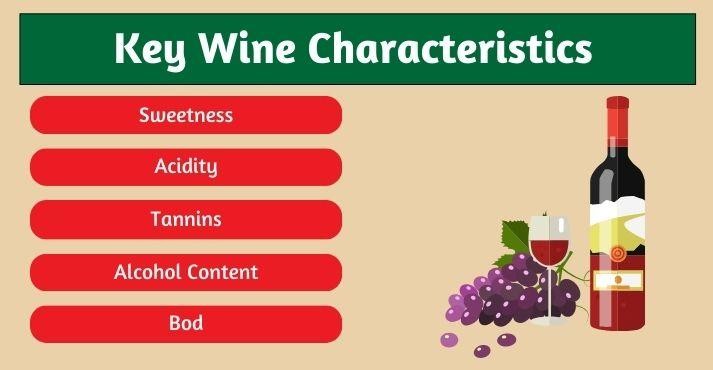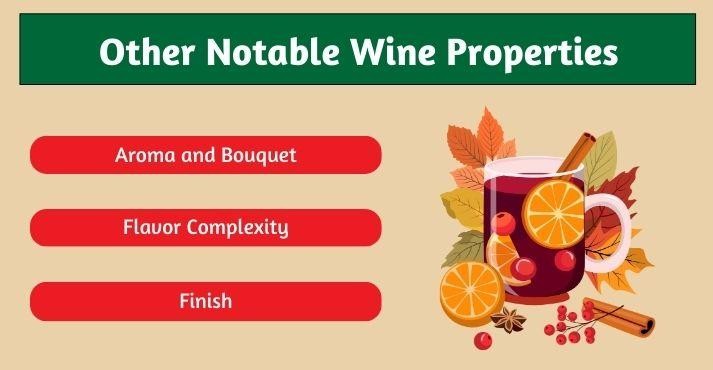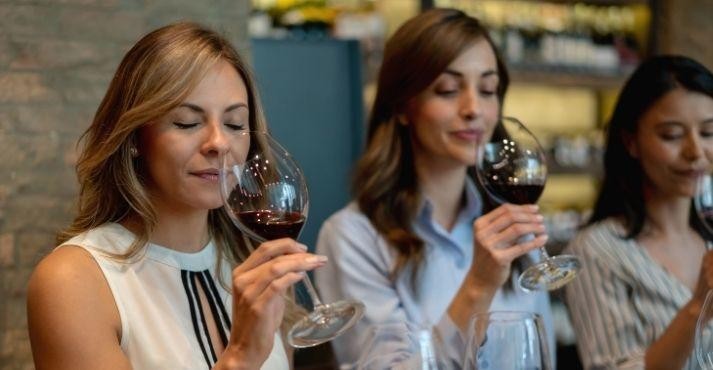Did you know that over 10,000 varieties of grapes exist worldwide, each bringing unique qualities to wine? Every wine has a distinctive personality, crafted by crucial characteristics that define its taste, aroma, and overall enjoyment.
Understanding these qualities allows us to better appreciate the artistry behind every bottle, whether it’s a simple table wine or a rare vintage.
This article will explore essential wine characteristics, such as sweetness, acidity, tannins, alcohol content, and body, giving you the tools to describe and understand wines.
Whether you’re a casual wine enthusiast or a hospitality professional, this guide will deepen your appreciation of wine’s distinctive qualities. Let’s start with the five main characteristics of a wine’s profile.
5 Key Characteristics of Wine

When appreciating a wine’s profile, five primary characteristics shape its flavor, aroma, and feel: sweetness, acidity, tannins, alcohol, and body.
These fundamental qualities define a wine’s unique personality, influencing its taste, how it pairs with food, and even how it ages.
Knowing these wine characteristics allows wine enthusiasts and professionals to describe and enjoy each bottle more fully. Let’s explore these critical characteristics in detail.
1. Sweetness
Sweetness is one of the first elements you’ll notice when tasting wine, as it is immediately felt on the tip of the tongue.
This characteristic of wine is determined by the amount of residual sugar left in the wine after fermentation, resulting in a spectrum of sweetness levels, from bone-dry to richly sweet. Sweetness affects the flavor and plays a significant role in food pairing, balancing flavors in a complementary way.
What is Sweetness in Wine?
The sweetness in wine comes from residual sugar, the sugar that remains after the fermentation process.
Depending on the winemaker’s style and the type of wine, this leftover sugar can vary, producing wines that range from dry (no definite sweetness) to very sweet (often called dessert wines). Sweetness can make a wine feel richer and more satisfying, adding depth to the tasting experience.
Sweetness Levels
- Dry Wines: Dry wines have little to no residual sugar, creating a crisp and refreshing taste. For instance, Sauvignon Blanc is often a dry white wine with a clean finish and minimal sweetness, which pairs well with seafood and salads.
- Off-Dry Wines: These wines have a slight hint of sweetness without being overly sugary. A wine like Riesling can have an off-dry profile, adding a mild sweetness that develops its fruity flavors while remaining balanced.
- Sweet Wines: Richly sweet wines like Sauternes or Moscato are often enjoyed as dessert wines. Their high residual sugar level creates a lush, almost honeyed taste, making them perfect for pairing with pastries or soft cheeses.
2. Acidity
Acidity is a fundamental wine property that contributes to its refreshing quality, adding brightness and crispness to the flavor profile. It’s the component that often makes a wine feel lively on the palate, with a sharpness that balances the fruitiness and sweetness of the wine.
The level of acidity in a wine is influenced by the grape variety, climate, and winemaking techniques, and it significantly affects the wine’s taste, texture, and ability to age.
How Acidity Affects Flavor and Structure
Acidity is crucial for a well-balanced wine, as it offsets sweetness and improves its structure. High acidity can make a wine taste zesty and crisp, giving it a refreshing quality, while low acidity results in a softer, rounder mouthfeel.
Additionally, acidity acts as a preservative, which helps wines with high acidity age gracefully over time.
High vs. Low Acidity Wines
- High Acidity: Wines with high acidity, such as Riesling and Chablis, have a bright, tangy profile that pairs beautifully with rich and creamy foods. The acidity cuts through the dish’s heaviness, creating a balanced dining experience.
- Low Acidity: Wines with lower acidity, like Merlot, offer a smooth, mellow taste that is easy to drink. The softer acidity level gives these wines a rounder texture, making them versatile choices for various foods.
3. Tannins
Tannins are a wine attribute that primarily affects red wines, contributing to their astringency, dryness, and complexity.
Tannins are naturally occurring compounds in grape skins, seeds, and stems. They give the wine its structure and texture. This characteristic is most noticeable in red wines, as they tend to have more tannin content due to prolonged contact with grape skins during fermentation.
Tannin Levels and Their Impact
The tannin level in a wine can vary greatly, influencing its flavor and aging potential. Wines with high tannin levels, like Cabernet Sauvignon, have a bold, structured profile that allows them to age well over time.
Tannins provide stability, making these wines suitable for cellaring. Conversely, wines with lower tannins, like Pinot Noir, have a softer, more delicate taste and are often preferred for immediate drinking.
Detecting Tannins in Wine Tasting
Tannins are often felt as a drying sensation on the tongue and gums, creating a slight bitterness that adds complexity.
For example, a wine with high tannins might give a mouth-puckering effect. In contrast, lower-tannin wines feel smoother and more approachable. Tannins can make a wine taste more sophisticated and layered, especially when balanced with acidity and fruitiness.
4. Alcohol Content
Alcohol is another crucial characteristic of wine. It is created during fermentation when yeast converts the grape sugars into alcohol.
The alcohol level affects not only the body and mouthfeel of the wine but also adds a warming sensation as you sip. Wines can vary widely in alcohol content, impacting their flavor intensity and weight on the palate.
Typical Alcohol Content Ranges
- Low Alcohol: Wines with 7–10% alcohol, such as Moscato and German Riesling, tend to be lighter and are often slightly sweet. These wines are ideal for refreshing, casual sipping and pair with lighter fare.
- Moderate Alcohol: Wines ranging from 11–13.5% alcohol, like Pinot Noir, offer a balanced drinking experience with moderate body and warmth. These wines are versatile for pairing with a range of dishes.
- High Alcohol: Wines with 14% or more alcohol, such as Zinfandel and Shiraz, are often full-bodied with bold, intense flavors. These wines pair well with hearty, robust dishes like grilled meats.
5. Body
The body of a wine describes its weight and fullness on the palate, influenced by a combination of wine properties such as alcohol, tannins, and sweetness.
A wine’s body is often described as light, medium, or complete, which significantly determines how the wine pairs with food and the overall drinking experience.
Light, Medium, and Full-Bodied Wines
- Light-Bodied: Light-bodied wines, such as Pinot Grigio, feel delicate and crisp, often refreshing. They are excellent for warm weather and pair well with lighter dishes like salads and seafood.
- Medium-Bodied: Wines like Merlot fall into the medium-bodied category, offering a balanced weight that complements a variety of foods. This versatility makes medium-bodied wines popular choices for social gatherings and dinners.
- Full-Bodied: Full-bodied wines, such as Chardonnay, have a rich, dense feel on the palate. These wines are best enjoyed with hearty meals like steak, as their boldness stands up well to robust flavors.
Other Notable Wine Characteristics

Beyond the five primary wine characteristics of sweetness, acidity, tannins, alcohol, and body, other qualities add richness, complexity, and depth to a wine’s profile.
These additional attributes—aroma and bouquet, flavor complexity, and finish, boost a wine’s overall appeal and contribute to the unique experience each wine offers.
1. Aroma and Bouquet
One of the most captivating aspects of wine is its scent, which can offer an array of distinct aromas and subtle notes. Aroma and bouquet are often used to describe a wine’s scent profile, though they refer to different aspects of its character.
- Aroma: This refers to the primary scents originating from the grape variety, usually fruity or floral. For instance, Chardonnay may offer green apple or citrus notes, while Cabernet Sauvignon might present blackcurrant or blackberry scents. These aromas come directly from the grape and are influenced by climate, soil, and growing conditions.
- Bouquet: The bouquet is the more complex set of scents that develop as the wine ages and ferments. Unlike the aroma, which is closely tied to the grape, the bouquet results from the wine’s aging process and its time in the barrel or bottle. Common bouquet scents include spices, leather, oak, or earthy undertones, which add depth to the wine. Aged wines might develop unique scents like tobacco, cedar, or truffle.
2. Flavor Complexity
Flavor complexity in wine refers to the range and depth of flavors that can be experienced from the first sip to the last.
A complex wine often has multiple layers, with each sip revealing new notes and nuances. This quality can make a wine more intriguing and enjoyable, offering a richer tasting experience.
- Layered Flavors: Some wines, particularly those made from complex grape varieties like Pinot Noir or Syrah, offer a series of flavors that unfold as you taste. For example, a Pinot Noir might start with red fruit notes like cherry or raspberry and then reveal earthy undertones such as mushroom or forest floor as it opens up.
- Influence of Terroir and Aging: A wine’s flavor complexity is influenced by its terroir (environmental factors like soil, climate, and terrain) and the aging process. For example, wines from cooler climates often have more delicate, nuanced flavors, while warmer-climate wines may be bolder and more fruit-forward. Aging in oak barrels can also add flavors like vanilla, caramel, or spice, adding further layers of complexity.
3. Finish
The finish of a wine is the lingering taste that remains after you’ve swallowed it. This final impression can vary widely among wines and is often a sign of quality and a vital indicator of a wine’s characteristics.
The length and quality of the finish contribute to the wine’s overall enjoyment and can influence how long you remember the wine after tasting it.
- Types of Finish: The finish can be short, medium, or long. A short finish means the flavors quickly fade after swallowing, while a long finish indicates flavors that linger on the palate. A wine with a long, complex finish is often considered higher in quality, as it provides a satisfying and memorable experience.
- Flavor Profile of the Finish: Some wines may finish with a burst of fruit, while others leave behind more earthy or spicy notes. For instance, a bold red wine like Cabernet Sauvignon might have a long, tannic finish with hints of dark chocolate or espresso, while a crisp white wine like Sauvignon Blanc may have a refreshing, citrusy finish.
Tips for Tasting and Identifying Wine Characteristics

Learning to taste and identify wine characteristics like a pro can transform your experience with each glass, whether you’re a casual wine drinker or a hospitality professional.
When you take this attribute time to explore the nuances of wine, you gain a deeper appreciation for the attributes of wine and develop a better understanding of what makes each bottle unique.
Here’s a guide to help you through the process and tips for hospitality staff to assist customers more effectively.
Process of Tasting Wine
Wine tasting is an art, with each step designed to engage the senses and bring out the wine’s unique qualities. Here’s a breakdown of the main steps in the tasting process:
1. Observe the Color
- Start by examining the wine’s color, clarity, and intensity. Hold the glass at an angle over a white background to get a proper look at its hue.
- The color can reveal clues about the wine’s age and type. For instance, white wines darken as they age, while red wines lose their vibrant hue over time, becoming more brick-colored or brownish.
2. Swirl the Wine
- Gently swirl the wine in your glass to release its aromas. This simple action helps to aerate the wine, bringing out its scents and allowing you to smell the complex layers.
- Swirling also reveals the wine’s “legs” (the droplets that form along the inside of the glass), which can give clues about its alcohol content and body. Fuller-bodied wines typically have more pronounced legs due to their higher alcohol or sugar content.
3. Smell the Wine
- The aroma of a wine is often its most distinctive characteristic. Bring the glass to your nose and take a gentle sniff. Note the primary scents you detect, which vary widely based on the grape variety, age, and winemaking process.
- Identify specific aromas like fruits, flowers, spices, or earthy tones. For instance, Sauvignon Blanc often has citrus or grassy notes, while Cabernet Sauvignon may offer blackcurrant, pepper, or even tobacco scents.
4. Taste the Wine
Take a small sip and let the wine coat your palate. Focus on the critical characteristics of wine—sweetness, acidity, tannins, alcohol, and body. Notice how these elements balance and interact.
Observe the wine’s flavor evolution as it moves through your mouth, and see if you can detect additional flavors as the wine warms slightly on your tongue. This step helps bring out the wine’s complexity and lets you experience its layers.
Consider the Finish:
- The finish, or aftertaste, is integral to the tasting experience. A long finish can indicate quality, as it indicates a well-balanced wine with depth.
- Note if the finish is short, medium, or long and what flavors linger after you swallow. Wines with a memorable finish often have a layered, pleasant aftertaste that leaves a lasting impression.
Training for Hospitality Professionals
Developing a refined sense of wine characteristics is essential for hospitality staff to provide excellent service.
Tasting regularly and practicing descriptive skills will increase their ability to assist customers with confidence and precision. Here are some tips for hospitality professionals to refine their wine-tasting skills:
1. Practice Tasting with Colleagues
Organize regular tasting sessions to practice identifying key wine properties like sweetness, acidity, tannins, and body.
Discussing wines with colleagues can improve your descriptive language and help you discover new ways to explain wine characteristics to customers, such as mentioning minerality in wine or its mouthfeel after the first sip.
2. Build a Wine Vocabulary
Knowing the standard wine terms used to describe wine qualities is invaluable. Words like “crisp,” “smooth,” “velvety,” or “earthy” can help you convey a wine’s profile accurately to customers.
Use reference guides provided by organizations like the Wine & Spirit Education Trust (WSET) to build a strong wine vocabulary.
3. Focus on Regional Differences
Knowing the distinct characteristics of wines from popular regions can augment your recommendations. For example, Bordeaux wines are known for their tannic structure and dark fruit notes, while New Zealand Sauvignon Blanc typically has vibrant acidity and tropical flavors.
Comprehending regional characteristics allows you to connect with customers looking for a specific style.
4. Study Food and Wine Pairings
A key part of helping customers select wines is suggesting wine-food pairings. For example, wines high in acidity, like Riesling or Champagne, can balance rich or spicy dishes, making them popular in Southeast Asian cuisine.
Learning about classic pairings and experimenting with local cuisine helps you make recommendations that suit the dining experience.
5. Encourage Customer Interaction
When serving customers, ask them about their preferences and be open to discussing different wine attributes.
For instance, if a customer enjoys a “smooth” quality, you can suggest wines with similar tannin levels or body. A personal approach nurtures a better customer experience and shows that you value their unique preferences.
Conclusion
Recognizing the five characteristics of wine, sweetness, acidity, tannins, alcohol content, and body, along with other unique attributes, opens up a world of appreciation for winemaking.
Each bottle tells a story shaped by grape variety, climate, region, and the winemaker’s skill, making wine a unique experience in every glass.
When recognizing these qualities, we can explore wines more deeply, finding new flavors, aromas, and texture layers with each sip.
You can be a seasoned wine lover or just beginning to discover the world of wine, and taking the time to notice these characteristics can make each taste memorable.
So, next time you pour a glass, pause to explore its distinct characteristics, let the flavors linger, and savor the artistry that brings each wine to life.





























